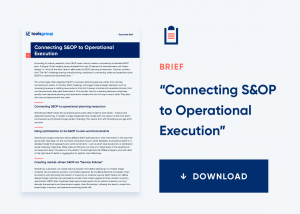Sales & Operations Planning: Bridge Strategy and Execution
Sales & Operations Planning: Why Execution is Essential
In today’s fast-changing business environment, Sales and Operations Planning (S&OP) is essential for aligning demand, supply, and financials goals. Yet, despite significant investments in tools and talent, many organizations still struggle to connect strategic vision with real-world operations. The result? Underwhelming S&OP outcomes and lost opportunities.
To succeed, businesses must close the gap between planning and execution. This means going beyond high-level forecasts to embrace tools and practices—like Demand Collaboration, Scenario Planning, and detailed modeling—that make Sales & Operations Planning actionable, dynamic, and performance-driven.
Why Sales & Operations Planning Falls Short
The purpose of Sales & Operations Planning is to create a synchronized approach between commercial and operational teams. Ideally, it connects sales, marketing, supply chain, finance, and operations in a seamless flow. Most S&OP efforts break down due to disconnected systems, siloed data, and a lack of cross-functional engagement.
According to Gartner, early stages of S&OP maturity often lack formal processes, metrics, and cross-functional participation. This limits the organization’s ability to identify risks, seize opportunities, and support decision-making over mid- to long-term horizons.
Without structured, integrated practices, strategic plans often remain abstract and are difficult to translate into day-to-day execution.
The Planning Gap: From Forecasts to Execution
A core issue with many S&OP initiatives is their dependence on aggregated data for planning—while successful execution requires granularity. Tactical forecasts often focus on product families or categories, but operational performance is determined by SKU-level decisions, location-specific constraints, and time-sensitive actions.
As Gartner highlights, companies tend to prioritize improving forecast accuracy to strengthen S&OP results. However, many overlook the need to leverage supply planning capabilities effectively—missing a vital opportunity to align operational plans and optimize business outcomes.
Collaboration and Optimization Must Coexist
Successful Sales & Operations Planning requires two core capabilities:
- Demand Collaboration – Shared visibility across departments, from sales to logistics, enables consensus building and unified forecasts.
- Optimization – Advanced modeling of real-world constraints like capacity, lead times, and inventory ensures efficient execution.
Some organizations do collaboration well. Others excel at modeling and optimization. But few can achieve both within a single, integrated S&OP framework. Without a unified platform that supports both, businesses are often forced to choose between alignment and efficiency.
Gartner also emphasizes the importance of stronger links between S&OP and Sales and Operations Execution (S&OE) processes to ensure timely, informed decisions based on real-world operational detail.
A Unified S&OP Data Model Drives Success
To unlock the full potential of Sales & Operations Planning, companies must implement a single, integrated data model. This model should support:
- Cross-functional collaboration
- Real-time scenario planning
- Execution-ready forecasts
- Data consistency across teams
A unified model eliminated silos, ensures all teams work from the same assumptions, and provides the foundation for fast, data-driven decision-making.
ToolsGroup’s Sales & Operations Planning Advantage
ToolsGroup offers a next-generation S&OP platform that adapts to your organization—not the other way around. It connects strategy and execution with features built for modern supply chains:
1. Scenario Planning for Real-Time Decisions
Run what-if simulations for pricing, promotions, inventory, or supply changes. This allows teams to make informed trade-offs and respond proactively to market shifts.
2. Demand Collaboration with Role-Based Workflows
Engage all stakeholders through a collaborative interface that tracks contributions, manages tasks, and supports continuous alignment throughout the Sales & Operations Planning process.
3. Sales Planning That Respects Operational Constraints
With integrated modeling, marketing and sales can see how campaigns will impact production and logistics—ensuring executable plans, not just forecasts.
Why Execution-Ready S&OP Matters
Gartner urges companies to ask critical questions about their plans: Is our plan realistic? What can we do now? These questions highlight the need for execution-focused planning—not just theoretical alignment.
Without a model that reflects operational realities, Sales and Operations Planning efforts cannot deliver results. An effective strategy closes this gap by enabling businesses to simulate, validate, and act on decisions that align with both strategy and execution.
Data Without Overload
In the age of big data, the challenge is not access, but usability. A good process simplifies this by delivering relevant real-time information to decision-makers. This transparency improves confidence and accountability across the business.

Achieving Alignment Across Teams
One of the hardest challenges in Sales and Operations Planning is balancing competing goals: Sales teams want to boost revenue, operations teams aim to control costs, and finance wants to protect margins.
ToolsGroup enables all functions to collaborate using a shared data foundation—modeling trade-offs and clarifying the business impact of each decision. This is how alignment is achieved in practice, not just theory.
Final Thought: If It’s Not Executable, It’s Not S&OP
A plan without execution is just a forecast. Sales & Operations Planning must be executable, data-driven, and collaborative.
With ToolsGroup’s AI-powered S&OP solution, companies connect strategic plans with day-to-day operations—delivering on the full promise of S&OP.
Click on the button below to download our Executive Brief – Connecting S&OP to Operational Execution.








